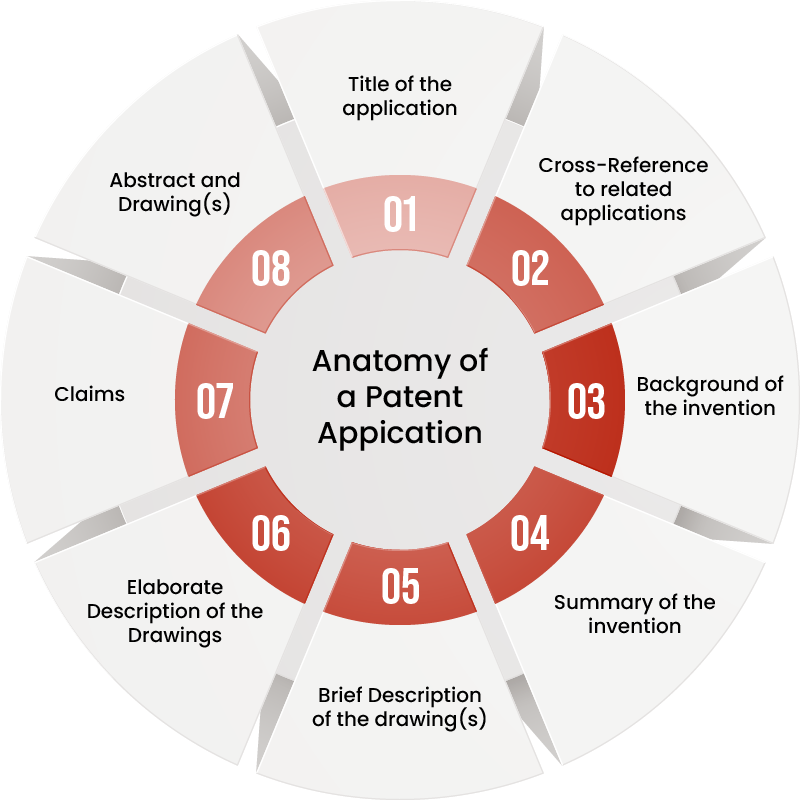Each component should be highlighted for its originality and creativity.
Prior to writing, a claim strategy that combines novelty and inventiveness should be developed.
Illustration: Herbicidal composition for controlling weeds.
Title of the Invention
With a word restriction of fifteen, the title should sufficiently describe the invention’s subject matter and specific features.
Possible Titles referencing the above illustration:
“Broad Spectrum Herbicidal Composition for Controlling Both Narrow- And Broad-Leaved Weeds”
“Herbicidal Composition for Controlling Weeds”
Note: The title shouldn’t contain any fancy words like “unique,” “novel,” “better,” “great,” or “best,” etc.
Field of the Invention
Describes briefly the subject matter, benefits, areas of application, and preferred use of the invention.
The present invention relates to a synergistic, broad spectrum herbicidal composition for controlling both narrow and broad-leaved weeds in leguminous crops, preferably Soybean.
Background of the Invention
State-of-the-art technology (Prior Art) and the problem that has to be solved should be made evident in the background. The indication must highlight scientific publications, patents, and other developments in the sector.
Problems to be Solved:
In modernized agriculture today, considerable attention is being given to all aspects of crop production, especially to those, that concern the defense of crops against weeds, diseases, insects, and pests.
In the last few years, a spurt in agricultural production is due to the green revolution, increased fertilizer use, crop production, improved irrigation, and infrastructural facilities.
The important challenge confronted in farming today in the production practices is weed management. Weed control using chemicals is much older.
Prior Arts:
US Patent 6713433B2 teaches a liquid concentrate herbicidal emulsion composition comprising oil-soluble and water-soluble herbicide formulation, and the patent EP 1202622B1 claims micro-emulsion formulation of water-soluble herbicide and graminicide.
Similarly, several other herbicides/weedicides are available in the market to protect crops.
Object of the Invention
The invention’s goal should be crystal obvious in highlighting the:
- The invention must be necessary.
- It must describe the technical issues with the current technology and how to solve them.
- It must highlight the differences between the claimed invention and the prior art; and
- It must make it clear what the invention’s intended use is.
The main object of the present invention is to provide a broad spectrum synergistic herbicidal formulation comprising a first active ingredient, which is Quizalofop, a second active ingredient, which is Fomesafen, and a third active ingredient, which is Imazethapyr.
Yet another object of the invention is to provide an herbicidal formulation comprising the active ingredient combination of Quizalofop, Fomesafen, and Imazethapyr wherein each active ingredient along with suitable safer adjuvants is formulated into suspension concentrate.
Yet another object of the present invention is to provide an herbicidal water-based formulation that has high herbicidal efficacy without any phytotoxicity on soybean crops.
Yet another object of the present invention is to provide a herbicidal formulation that is useful for resistance management in weeds.
Summary of the Invention
Before providing the details of the invention and the method of performing it in the following section, the summary of the invention briefly describes the invention’s embodiments.
The claim should unambiguously state the distinctive innovative characteristics and originality of the invention for which protection is sought.
According to the present invention, there is provided a synergistic herbicidal composition, comprising:
- a herbicidally effective amount of Quizalofop- including its agriculturally acceptable salts and esters thereof;
- a herbicidally effective amount of Fomesafen; and
- a herbicidally effective amount of Imazethapyr
Brief Description of the Drawings
As was previously noted, an examiner would typically not request a model, prototype, or finished product; therefore, to effectively convey the product, as many drawings as feasible should be added.
Detailed Description of the Invention
A thorough picture of the invention should be supplied because the major goal of the detailed description is to allow a person experienced in the field to put the invention into practice without further experimentation.
Claims
In the event that a patent is issued for an innovation, claims outline the boundaries of the rights. Therefore, the most important component of a patent application is the claims.
A comprehensive specification follows the description with claims. Since claims specify the boundaries of legal protection, it is advised that they be carefully prepared to address all aspects of the protection sought while sufficiently separating the claimed invention from the prior art.
Typically, a claim has three components: Preamble, Transitional phrase; and Body.
A synergistic herbicidal composition comprising:
- Quizalofop including its agriculturally acceptable salts and esters thereof;
- Fomesafen; and
- Imazethapyr.
Abstract
An abstract is a succinct summary of the information in the specification that clearly identifies the technical field to which the invention belongs, the technical issue to which it relates, the solution to the issue provided by the invention, and the invention’s primary use or uses.
As mentioned above, the abstract should be brief; for this reason, it is just 150 words long.
The present invention provides a novel synergistic combination of three herbicides, Quizalofop, Fomesafen, and Imazethapyr, which at particular weight concentration(s) ranges, exhibit synergistic inhibition of narrow- and broad-leaved weeds in crops, particularly soyabean. Also provided in the present invention are formulations comprising said actives, and method of preparation thereof.






